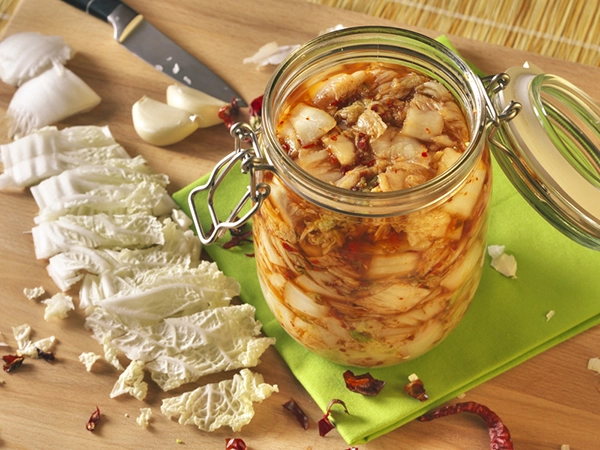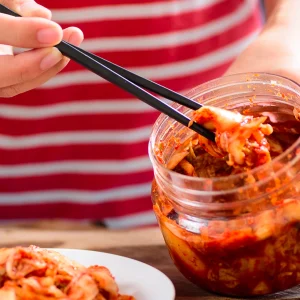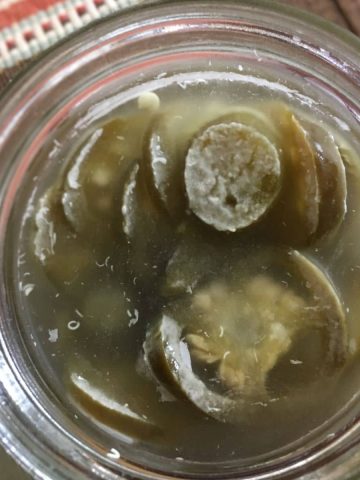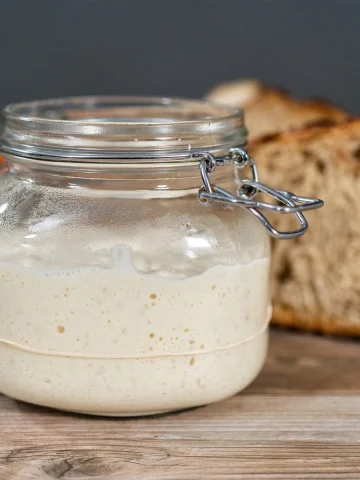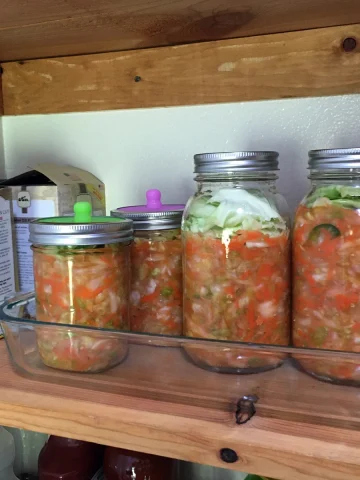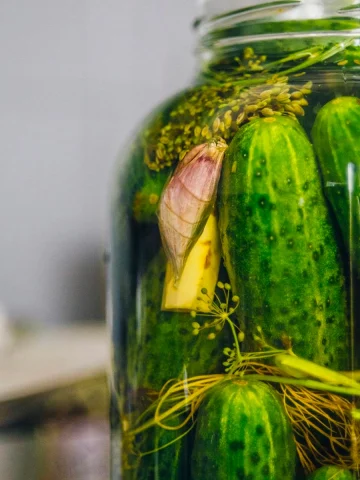How Long Does Kimchi Last? Does Kimchi Go Bad?
This article covers how long does kimchi last, whether kimchi can go bad, and discusses best practices for storing it safely.
So you've got a beautiful jar of delicious kimchi in your pantry or refrigerator, and you want to know how long it will last. Kimchi, or kimchee, is an extremely popular Korean side dish made by fermenting napa cabbage with salt, Korean chili powder (Gochugaru), garlic, green onion, and other spices.
It is high in acid, which lowers the pH; it can last a reasonably long time if your kimchi is appropriately stored and handled. This is excellent news!
How Long Can An Unopened Jar of Kimchi Last?
If the kimchi has not been opened and stored in a cool, dry, and dark place, it will generally remain tasty and usable for at least one year to 18 months.
How Long Does Kimchi Last Once Opened?
While stored in the refrigerator, kimchi can last three to six months.
Opened jars of kimchi may have a shorter shelf life, especially if bacteria have been introduced (like from your mouth touching a fork and then putting it back in the jar).
The cooler temperatures in a refrigerator will help kimchi last longer because it slows the fermentation process down significantly.
The fermentation process slows down when in colder temperatures, making it possible for kimchi to have an extended shelf life.
Tips To Help Kimchi Last Longer:
- Keep kimchi in an airtight container with a secure lid for best results.
- If you have a large kimchi container, it helps to break it up into several smaller jars.
- Opening the glass jar less often will prevent the kimchi from spoiling faster.
What Does Good Kimchi Taste Like?
Good kimchi is famous for its tangy, fizzy, salty, spicy fermented cabbage packed with flavor and umami funk. The kimchi you find in the refrigerator section at your local supermarket varies wildly in appearance, texture, and taste.
Learn more about why kimchi is fizzy.
Some are garlicky, and others are mild, sweet, vinegary, or so sour they'll make you pucker with a significant crunchier texture. Check out my article to learn more about what kimchi tastes like?
How Do I Know If Kimchi Has Gone Bad?
While it is uncommon for kimchi to go bad, here are some tips for determining if your kimchi has gone bad:
- Dark spots
- White slimy film
- Mold growth that is perhaps fuzzy white, green, or black
- Smells 'off' or like alcohol
It's essential to know the telltale signs when your kimchi is bad. This is where your keen senses come in! How does your kimchi look? How does it smell? And lastly, how does it taste?
As the adage goes, "Look first, then touch!" If your kimchi looks and smells okay, it likely won't hurt you if you taste some, even if it's close to going bad. So, always look and smell before you eat.
As long as it smells normal and does not have mold growing on it, kimchi is good to eat.
Kimchi which is still good will retain a rich, vibrant, and colorful appearance. It will not look dull or lifeless but will have a certain freshness. The vegetables will be plump, and you won't see any of the following:
Once you've given a thumbs up on the visual of your kimchi, you can then smell it for further analysis. Typically, kimchi is very strong smelling and pungent, spicy, and slightly sour to quite sour. The vapor will tickle your nose!
Good kimchi has a naturally pungent umami aroma, kimchi that has gone bad may smell "off," meaning sourer than usual, or even have an alcoholic scent.
Dump out Kimchi that smells like alcohol or has a strong, pungent smell that is so strong that it is unpleasant or grosses you out.
Dump out old kimchi with a fuzzy mass, white film, or small dots that ranges in color from black to blue to green growing on it. If mold is present, do not smell it, as inhaling its spores may trigger respiratory problems.
Mold is dangerous because it rots food and may harbor bad bacteria that cause food poisoning or allergic reactions.
Kimchi With Fish Sauce or Seafood
While kimchi can contain some amount of fish sauce, anchovy paste, or oyster sauce, which are added to boost the savory, umami, and flavor notes, your kimchi should not smell fishy, per se.
Kimchi that contains seafood such as fish sauce, oysters, and fermented fish that has gone bad can give you severe foodborne illnesses.
An intensely fishy or offensive odor is not a good sign, and it's also the time to remember that famous saying, "When in doubt, throw it out!"
In other words, it's best not to go ahead and do a taste test, as the kimchi will very likely not taste good if it doesn't already smell good. Save yourself the bad experience!
If your kimchi has passed the appearance and the smell tests, you can perform a taste test. Yes, you should expect kimchi to taste sour, and it's good to remember that as your kimchi ages, it will become sourer.
This sour feature is not a negative unless the kimchi is just too tart and not to your liking. Sourness and potency from the intense garlic and spices aside, if your kimchi doesn't taste right, don't eat it.
Kimchi should be enjoyed and savored, and if neither is possible, trust your senses and discard it.
Can You Eat Kimchi After The Expiration Date?
Kimchi is OK to eat after the expiration date. Expiration dates are mostly only for stores to track how long they should keep things on the shelves. Kimchi traditionally sits in jars for months or longer before it's even eaten.
If you have a kimchi jar sitting in the back of the fridge long after the expiration date, you might still be able to eat it. It is a good idea to go through the steps of checking the smell, look, and taste before eating a bunch of it.
Beware of kimchi with fish ingredients such as clams, oysters, anchovies, or fish sauce; it could lead to foodborne illnesses such as food poisoning. Therefore you must look at the ingredients list.
Some symptoms of food poisoning include vomiting, nausea, severe cramping, fever, and diarrhea for a few days. Consult a doctor if you experience such symptoms.
Overall, kimchi is a delicious and healthy food that can be kept and utilized in all its glory for relatively long periods. However, to continue your enjoyment of this Korean staple, it's best to know what it should and should not look, smell and taste like.
Consuming bad kimchi is not a pleasant experience and can be pretty dangerous. So, make sure you take steps to keep your kimchi in the best condition so that you will only have great experiences with it. After all, who doesn't want to add a little spice to their life!
How To Store Kimchi in the Refrigerator Without the Smell
The kimchi smell is powerful, and if it's stored unproperly can make the whole refrigerator smell. Even after closing the door, the odor can remain in the kitchen.
How to properly store kimchi in the fridge without the smell:
- Store the kimchi in an airtight container such as a jar or glass Tupperware.
- Top the kimchi with plastic wrap, and push it down to release any air.
- Close the lid tightly.
- Bag it a second time by putting the jar into a freezer ziplock bag and sealing the bag.
- Keep an opened box of baking soda or coffee grounds in the fridge to help absorb the kimchi odor.
- Limit the number of times you open and close the container.
The Best Storage Containers for Kimchi
Glass is best for storing kimchi. Acidic foods like kimchi do not react to glass because glass is nonporous, so it doesn't absorb flavors as plastic does.
Assuming that you've purchased or made good quality kimchi, to begin with, the best way to assure its shelf-life and excellent eating quality is to store it properly. Here are some essential points to remember when storing your kimchee:
If you buy manufactured, shelf-stable kimchi from the grocery store, make sure the jar or container is free of any leaks, is vacuum sealed, and that the lid is still secured tightly.
If you want to store your purchased and unopened kimchi for use at a later date, you can keep it in a cupboard or pantry that will serve as a cool, dry, and dark storage location until you are ready to start using your kimchi.
A year is a typical time before you open and use your kimchi from the pantry. However, why would anyone want to wait so long for something so good?
If, instead, you open your off-the-shelf product, or you make, or buy fresh kimchi, say from an Asian market, you will likely need to carefully transfer your product into two containers before putting it in the refrigerator. Place the amount of kimchi you think you will be using for the week into a smaller container sealed with a tight-fitting lid.
Put this container right into the fridge in an easy-to-get-to location. Once your kimchi goes into the refrigerator, you have three to six months to use it.
For the remainder of your kimchi, place it in a larger container, pressing it down to keep all the pieces and layers compact and touching. Pour any excess liquid or brine over the kimchi. Then, place an oversized piece of plastic wrap directly onto the kimchi.
Finally, seal the container with a snug lid. The plastic wrap keeps air from getting to your kimchi, reducing oxidation and mold growth. This container also has about a three to six-month life.
Tips for a Long Shelf Life of Kimchi
Whether you are eating homemade kimchi or a brand from grocery stores, it is important to follow proper sanitation practices to prevent contamination by spoilage or harmful bacteria.
This will involve thorough hand-washing, cleaning equipment, and cleaning surfaces throughout all preparation steps.
One sure way to make kimchi go bad fast is by eating the kimchi right out of the stored jar. Always use clean utensils to take kimchi out of the jar.
What is a Kimchi Fridge?
A kimchi refrigerator is designed just for storing kimchi.
They provide a colder, more humid, and more consistent temperature than a conventional refrigerator. A kimchi fridge also has less moving air, providing a more consistent fermentation environment.
If you make a lot of Kimchi, you might want to invest in a Kimchi refrigerator.
CONVERT FROM FRIDGE TO FREEZER: Has a spacious chest with different temperature settings that you can adjust with the press of a button to go from fridge to freezer
Last update on 2025-08-07 / Affiliate links / Images from Amazon Product Advertising API
Why Buy a Kimchi Fridge?
Smell: The smell of Kimchi can undoubtedly be overpowering, so it is not pleasant to have in your main fridge amongst other food.
Storage time: a kimchi refrigerator will help the kimchi hold its taste and quality for much longer.
How is a Kimchi Refridgerator different from a regular refrigerator?
Super Precise Cooling: Maintain specific temperatures within plus/minus 1 degree F to create the optimal environment for fermenting kimchi and keeping fruits and vegetables fresher and longer.
How To Freeze Kimchi
Kimchi can have a long shelf life by freezing it in a plastic freezer bag or airtight container, preferably glass, such as mason jars with tightly screwed-on lids.
Glass and heavy plastic containers will protect the kimchi more than plastic bags. The better your storage container, the longer your freezer life will be, on the side towards many years, as opposed to only two years.
Kimchi can keep anywhere from two to seven years in the freezer.
Did I answer everything you wanted to know about whether kimchi goes bad and how long kimchi lasts?
Kimchi is a fermented food, making it an excellent probiotic source. Kimchi has the same lactobacilli bacteria found in yogurt and fermented foods such as sauerkraut and beet kvass. The healthy bacteria in kimchi can help you maintain healthy digestion and a strong immune system.
In this article, we talked about kimchi and how long it lasts both unopened and after it’s been opened.
We also talked about how to store kimchi properly so it last longer and whether you need to refrigerate your kimchi.

